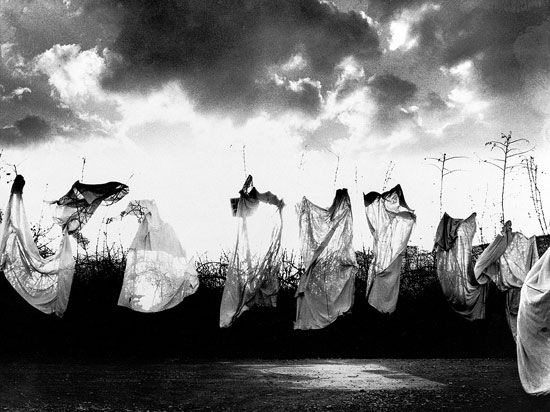Lace and Wind, or the Afterlife of Form
Written by Sama Moayeri
2020

Mario Giacomelli, Questo ricordo lo vorrei raccontare, 2000 © Mario Giacomelli
Strips of lace, suspended in mid-air, take the shape of a woman’s nightgown, yet no body claims them. They gather, circle each other like ghosts, caught in a choreography dictated not by human intention but by the indifferent push and pull of the wind. In Mario Giacomelli’s photograph, drawn from his *Death Will Come and It Will Have Your Eyes* series, grayscale ceases to be a mere absence of color. Instead, it becomes a new spectrum—one that extracts, from the void itself, a spectral palette: colors of forgetting, hues of disappearance. The image does not document reality so much as it reconstitutes it, staging a memory in the process of being born—a memory so faint, so brittle, that its reality feels suspect. The photograph implies a collective suicide, a mass vanishing of bodies, leaving behind only the garments they once inhabited. This void, emptied of human mastery, becomes a landscape in mourning—a field no longer under dominion, freed from the violence of presence. The survivors of this disappearance are not human; they are the spectral relics of the human—the forsaken lace, the perpetual bowing of light upon fabric, the field itself left to inherit the silence. What the image renders audible is not the absence of voice, but the aftersound—the immortal song of the wind that does not merely animate the lace, but also summons the grasses, the soil, the horizon itself into its dance. What they have left behind surpasses what they were. This is solitude transfigured, its beauty owing precisely to its refusal to be measured by any human scale. To perceive such beauty requires a gaze trained not on individual beings, but on existence itself—existence not as the sum of things, but as the interval between things. Giacomelli’s composition, with its stark insistence on the emptiness that follows disappearance, refuses the metaphor of redemption. This is not the afterlife as consolation, but the afterlife as aesthetic condition: the inevitable transformation of death into form. Giacomelli’s formalism resists the temptation to reduce reality to a single moment, a fixed point in time. Instead, he renders the real as a spiral—eternally returning, yet always out of reach. His is a realism haunted by the beautiful corpse of history, in which death is no tragedy, but a formal necessity. Forgetting, in Giacomelli’s aesthetic, is not an erasure but the very texture of memory—a plenitude born from absence. In this sense, Giacomelli offers not a commentary, but a vision: a vision of the eternal circularity at the heart of existence, stripped of all ethical burden. This is not a humanist beauty, but a posthuman one, delivered in a poetic syntax that insists on the nakedness of things, their radical nothingness. What remains, after the vanishing, are not the dead, but the trace of their misplaced grandeur—the garments they left behind, as if they once imagined themselves to be suns. And yet, perhaps only the moon—solitary, ensconced in its own darkness—is truly free.
Fair Use Notice: This website may contain copyrighted material used under the doctrine of Fair Use as outlined in Section 107 of the U.S. Copyright Act. Such material is made available for the purposes of commentary, critique, education, and scholarly research. All images and texts remain the property of their respective copyright holders. No copyright infringement is intended. If you are the rights holder and believe your work has been used improperly, please contact us to request removal or proper attribution.